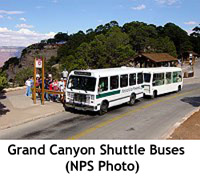Downtown Manhattan has nothing on the South Rim of the Grand Canyon when it comes to gridlock.
OK, that's stretching things a bit. But if you've ever visited the South Rim during the summer, you know that gridlock does indeed exist in the desert. And for years Grand Canyon National Park officials have been struggling to solve the mess.
Back in 2000, during work on America's National Parks for Dummies, I noted in the Grand Canyon chapter that "every year, an estimated 1.5 million private vehicles and another 30,000 tour buses converge on this side of the park. Smog blurs the views, and not enough parking lots are available to handle the traffic, so at the height of summer, you often encounter lines of rigs parked along the road. Not only are they ugly, but they're also dangerous for visitors and deadly for roadside vegetation."
Well, back in 2000 park officials thought a light-rail transit system would be on-line by 2004. But Congress never could get comfortable with the cost. So that brings us to the present, when park officials are ready to embark yet again on revising their transportation solution for the South Rim.
In the coming weeks park officials will hold a number of open houses to allow the public to learn what the next iteration of the transit plan might look like, to ask questions about some of the proposed solutions, and to even suggest solutions.
The scoping period, which officially opened March 17, runs through May 1. At the conclusion of the scoping period park staff will begin work on a visitor transportation plan and environmental assessment for the South Rim. That EA, when completed, will look at the impacts -- environmental and non-environmental -- that could result from the various proposals intended to solve the South Rim's mass-transit woes. The resulting solution, if one surfaces, is expected to have a shelf life running to 2020.
Whether a light-rail option will be included in the EA remains to be seen. Last June the park presented Congress with a report on various transportation alternatives, which looked at a mix of shuttle bus, light-rail and heavy-rail systems. Costs ranged from $115 million to $252 million, depending on which mix was selected. (You can find this 217-page report here; scroll down to the "Transit Report" section.)
An "Option A" has been formulated to placate those who find the regional rail plan too exorbitant. Still somewhat costly at nearly $100 million over a 20-year life, it relies on a range of shuttle bus routes, more parking lots, and traffic management. However, use of the mass transit would be optional.
In announcing the scoping period, park officials were upfront in saying that Option A may or may not be included in the final range of alternatives addressed by the upcoming EA.
What's the best solution? That's a very good question.
If money weren't an issue, I'd opt for the regional rail alternative, which would involve a heavy-rail line from Williams, Arizona, to Grand Canyon Village, as well as light-rail from Tusayan to the park's Canyon View Information Plaza. Under this scenario, visitors would have to take mass transit to the South Rim, as all day-use visitor traffic would be prohibited. Once visitors reached the South Rim, the park's shuttle buses would stand ready to move them about the rim.
Why, in light of the presumed inconvenience of having to board one of these trains with your baggage and kids in tow, do I like this option? It's cleaner, for starters. There would be less haze hanging over the Grand Canyon. And there'd be no chance of getting your rig into a fender-bender on the rim.
Too, things would be much quieter once you arrive on the rim. And you wouldn't have to worry all the time about being run down while crossing the street, say, from Canyon View Information Plaza to the market.
Mass-transit solutions at Zion and Acadia national parks have been well-received, and I think one at Grand Canyon would be too. It just seems like this option would be best for the park and best for visitors enjoying the park.
Option A is only a partial solution to the problems confronting the South Rim. Heck, it would only reduce day-use traffic through the park's South Entrance to Grand Canyon Village by an estimated 15-25 percent.
Of course, all these scenarios, and any that evolve out of the scoping period, require a substantial amount of pocket change. Whether Congress would agree outright to underwrite the bill, or whether the evolving plan would require NPS funding, which likely would be dripped out over the years in light of the agency's current funding woes, is a big question mark.
I suppose it's even likely that the chosen alternative will never get off the launching pad. After all, it was almost a decade ago when Grand Canyon officials thought light-rail would be a reality in the near future, and that plan never got off the ground because of its cost.
As for the upcoming public meetings, on April 5 there will be one at the Henderson Convention Center in Las Vegas; on April 6 there will be one at Mesa Community College in Mesa, Arizona; on April 11 one will be held in Flagstaff, Arizona, at the Museum of Northern Arizona, and; on April 12 one will be held in Tusayan. The first three meetings run from 4 p.m. to 8 p.m., while the last one starts at 4:30 p.m. and goes until 8:30 p.m.



Add comment